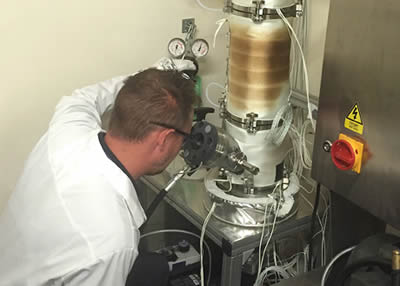| GKN Aerospace has patents approved covering a new ‘benchtop’ ice adhesion test device which incorporates apparatus to simulate icing conditions and then determine ice adhesion in situ.
This will enable swifter, less costly assessment of promising ice phobic coatings and other ice protection technologies.
Russ
Dunn, Senior Vice President, Engineering & Technology, GKN Aerospace, explains: “Effective ice protection, including icephobic coatings, is a key focus for aerospace, as preventing ice accretion is a critical safety requirement. Efficient ice protection systems lower power consumption, improving aircraft efficiency and lowering emissions. To date, the most comprehensive method for measuring and understanding the icephobic nature of a surface is through icing tests using a wind tunnel. These require large, dedicated wind tunnel facilities, making them costly and impractical for regular use as a development tool, or for batch quality control in production.”
| The new device comprises a test chamber with a water ejection system and ice adhesion test apparatus. Water droplets are ejected and fall through the interior of a cooled column, becoming
supercooled. They freeze on impact with the surface under analysis, situated at the base of the column. Parameters such as the distance from the water nozzles to the surface, the size of the water droplets, |
|
 |
|
Testing the ice adhesion performance of a GKN Aerospace-developed icephobic coating inside GKN Aerospace’s new benchtop test device. |
| the test area and test temperature can all be adjusted to achieve representative environmental conditions. Once the desired ice layer is achieved its adhesion to the surface can be tested within the chamber, with both ice accretion and the adhesion tests viewable through a port on its side. |
Dunn continues: “Although more extensive trials are required to fully understand how to optimise settings and analyse data, we believe this new method of testing ice accretion will speed the development of ice-phobic coatings and other ice protection technologies by reducing the cost and time involved in testing - and by enabling more testing at an earlier stage in the development cycle, the quality and focus of development programmes will also improve. Wind tunnel testing would then be more effectively applied in large scale and system performance verification tests."
|

